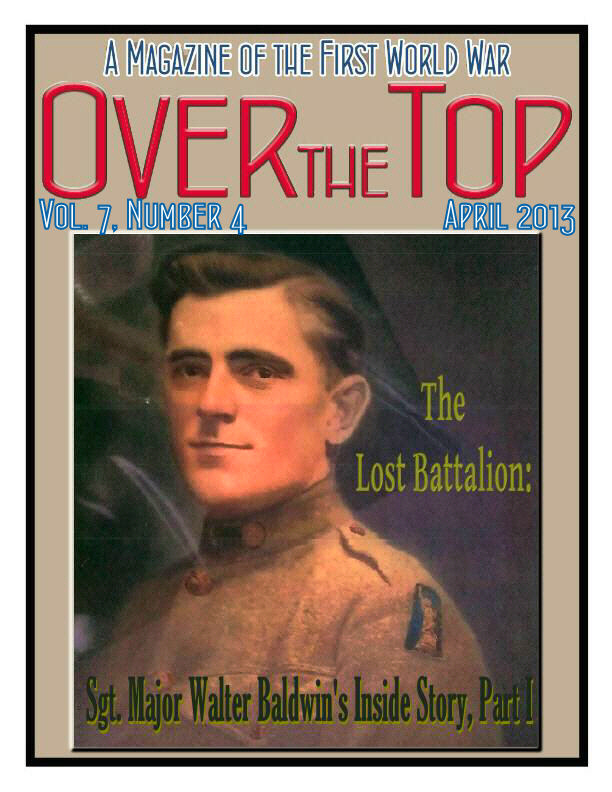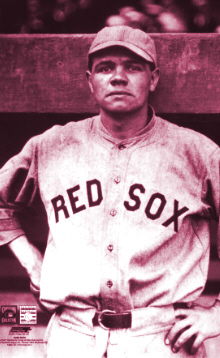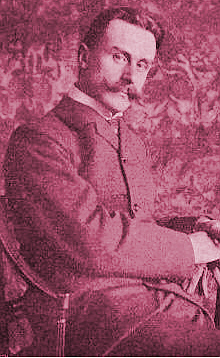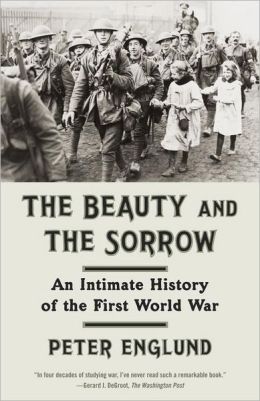

April 1913
Turmoil Over Albania Keeps the Balkans Roiling
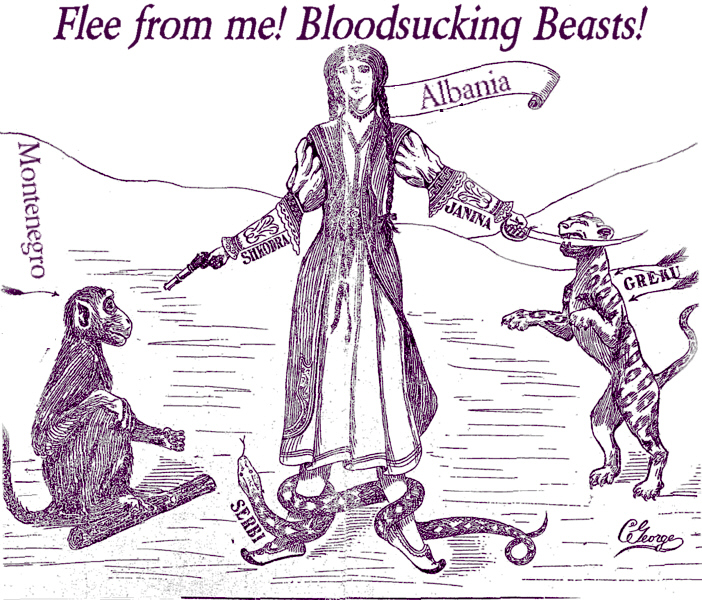
Albania Defending Itself
from Neighboring Countries |
When the Balkan Alliance began its war with Turkey in 1912 Austria-Hungary considered itself directly and vitally affected. Not only did it see danger to its ambition to reach the Aegean, but it considered that a powerful Serbian state might be dangerous if it reached the Adriatic Sea and developed a navy, since under the influence of Russia Serbia might attempt to close altogether Austria's only ocean outlet. The Alliance preferred a scheme for erecting a buffer state, Albania, between Serbia and the sea, whose ports might be used by Serbia for commerce but not for developing naval power. Serbian politicians, taking advantage of the retreat of the Ottomans, accelerated matters by declaring independence in November 1912. At a ministerial conference in London the next month, with both Austria-Hungary and Italy pushing for an independent Albania, the representatives concurred. In January, the Serbians conceded and supported the new state, with certain territorial conditions.
Montenegro, which had initiated the First Balkan War, however, still had its own ambitions in the region—namely the capture of the affluent trading center of Scutari (Shkodra) in northern Albania, to which it was still laying siege. After suffering heavy casualties, the Montenegrins received the surrender of the Turkish commander, Esad Pasha, on 23 April. The ambassadors in London, however, had already decided that the city would be part of the new Albania. To effect this, however, the Montenegrins needed to be administered a potion of Austrian saber-rattling, British and Italian gunboat diplomacy, and a "Russian Uncle" lecture from the Tsar. Things seemed to settle down with the drawing down of the First Balkan war, which concluded with the signing of the Treaty of London on 30 May. This was Balkan calm was brief, though. In June, Bulgaria, dissatisfied with its spoils from the First Balkan war, would start a new regional war; and in June, an ever-ambitious Serbia would trigger a second crisis in Albania, both keeping the big powers on edge about their fluctuating fortunes in the region. Sources: Mt. Holyoke College Website for content, Wikipedia for the cartoon
|


Earlier this month, I promised a new design by 1 June. It turns out we need feedback from our readers and contributors to make sure the Trip-Wire is readable and as informative as ever. Here we have simply placed the April & May issue in the new format. There will be some further reorganizing as we tie together Trip-Wire and our new blog Roads to the Great War. Please send us your comments on the new design (email). Also, you might check out our new portal page at: worldwar1.com. MH
 Click on Title or Icon to Access
Click on Title or Icon to Access
|
|
2013 Events
Paul Cora, Chairman of the Western Front Association East Coast Branch, has announced the creation of The World War 1 Centennial Network. It is a cooperative alliance of organizations, museums. and historic sites in the U.S. for the purposes of cross-promoting our various WW1 activities, and boosting public awareness of the coming centenary of the war. The network's website has recently gone live and can be viewed at: www.ww1-centennial.org
Western Front Association East Coast Branch has also announced their Spring 2013 Symposium: Saturday, 1 June at the Fifth Regiment Armory, Baltimore. Download pdf flyer
The Great War on the Eastern Front Symposium; National WWI Museum, Kansas City, 13 April. Download Word Doc Flyer
2014 Centennial Events
Vienna Philharmonic to Open Centennial Commemoration at Sarajevo 28 June 2014
Christmas Truce News: Major events are being planned including reenactments and soccer matches at both Ploegsteert (Plugstreet)—the Bruce Bairnsfather site)—and Frelinghien, near Armentieres. More details in future issues.
Still searching for news or announcements and specifics on the following 1914-2014 events: Siege of Liège, the BEF Deployed, Battle of Mons, First Battle of the Marne, and the First Battle of Ypres. Please send any news you run across (email).
2015 Centennial Events
Limits on Attendance for 100th Anzac Day
|
|
U.S. Propaganda Poster
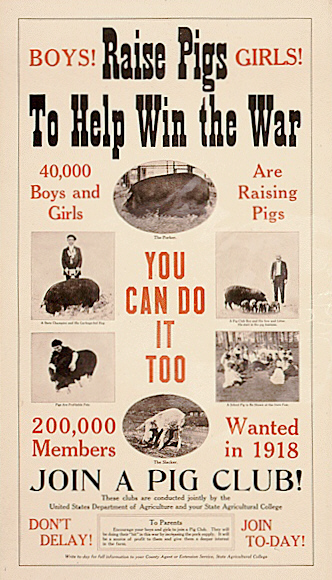
U.S Food Administration, 1917

Serbia's Black Hand Society
Gavrilo Princip and his crew did the deed, but the Black Hand secret society (officially known as "Unification or Death") led by Serbian army officer, assassin, conspirator, and terrorist Dragutin Dimitrijevic (code name "Apis") gave them their mission and support. Here are some websites where their story is told.
Overview of the Black Hand by Michael Shackelford
Constitution of the Black Hand
Dragutin Dimitrijevic Biographical Sketch
Sarajevo: The Story of a Political Murder by Joachim Remak
(Chapters 4 & 5 on the conspiracy and preparations especially recommended)
Nikola Pasic, Destroyer of the Black Hand

American ace Frank Luke is immortalized as the "Balloon Buster." But the greatest "Balloon Buster" of the war may have been Belgian Willy Coppens, who destroyed 35 observation balloons in 18 months of flying. (Luke downed 14 balloons in 3 months.)

The air in the dugout is so foul that I sit by the entrance. Walter Mayer and Hendrich from my squad sit next to me. Hendrich has completely lost his composure. He is down on his knees and prays. Mayer loses all patience. He tells him off. In this situation a prayer is senseless... Our roof is blown apart by a 28 cm shell. Because I am sitting by the entrance, I am left unscathed, just shoved inside. Most of the men are dead.
Walter Pechtold, German soldier, 1918
|

|
|
|

Brothels at War
Here are two photos taken during the Great War showing brothels for soldiers. Both were taken on the Eastern Front, though of course such activity and establishments were to found in every theater of war.
Such photos are, however, not easy to find. Obviously, virtually none were published in the mainstream media—except for one example here in which the photo editor must have been extremely naive or having a private joke. Most photos of brothels, sex workers, and the like were published in the postwar period in various pacifist, anti-militarist books edited by the German activist Ernst Friedrich (1894-1967). "Krieg dem Kriege" (Make War Against War) was essentially a collection of horrific photos that intended to show the horrors of war to the general public. The images were generally provided by veterans sympathetic to the anti-war cause and were often private souvenir photos taken during the war years. Some were also purloined from military or hospital archives. They showed mass graves, trenches filled with the dead, decomposing bodies on battlefields, horrific wounds, executions and hangings, and also a number of photos of brothels that were set up to cater to the needs of German and Austrian soldiers. By including these photos in a militant anti-war publication, Friedrich meant to show the demoralizing and socially debilitating effect of all aspects of warfare to the general public.
There were also several French interwar publications that were advertised as showing for the first time "Secret Images from the War". Often the imagery was taken from Friedrich's publications, which, as anti-war material, were freely and widely distributed in countless formats and sizes. Oddly enough though, as if in keeping with the wartime tendency of vilifying the German enemy, no photos of French or other Allied nation brothels or bawdy houses were used. This even though, as everyone knew, prostitution in France (and Belgium) was completely legal and regulated by laws and ordinances. TL
|
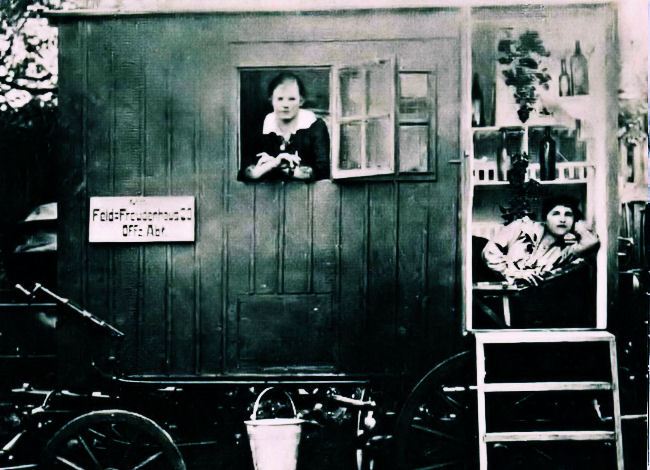
This is a photo of a mobile brothel as used by the Austrian Army. The sign designates it as "Mobile Pleasure House number 20—for officers only."
|
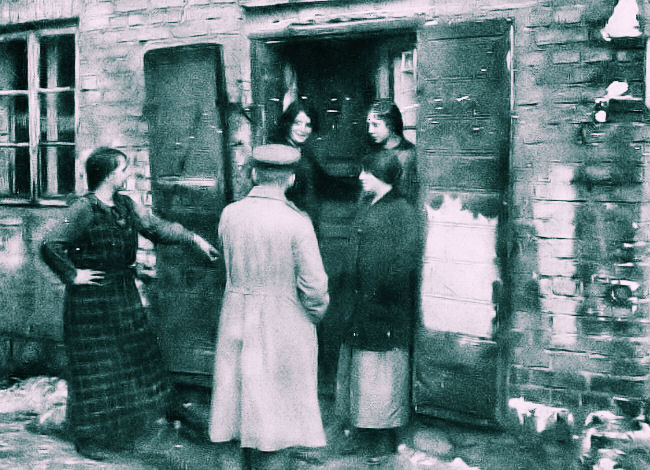
This photo appeared, by mistake no doubt, in a German family newsmagazine called Die Woche (The Week). The caption announces the building as a "teahouse" in the Galician city of Lida, whose friendly attendants warmly welcome our soldiers. Upon a second look, there seem to be quite a number of young waitresses for such a rundown-looking establishment. Besides, on the Eastern Front, coffee or tea houses were virtually synonymous with brothels. The photo editor was either quite naive to let this photo appear in a family magazine or else having a private joke. In any case, it is one of the very few photos of a brothel ever to appear in print in the regular media during the war.
|
|
|

Battleship Hill:
Turkish Bastion at Anzac
The 25th of April will mark the 98th Anniversary of the beginning of the land campaign at Gallipoli. The
Anzacs' objective that day— and for the entire campaign— was to capture Sari Bar, the highest ridge above the landing beaches, especially its central peak, named Chunuk Bair. The southernmost hill of
Sari Bair, actually a flat double-peaked formation, became the key defensive point that day for the Turkish troops commanded by Mustafa Kemal. It blocked the direct approach to
Chunuk Bair from the south and southwest. The taller hilltop was known locally as Düztepe (Flat Hill). The
Allies initially used the terminology Big 700 for this more-northern, taller summit, and Baby 700 for the lower. The name
Big 700, however, only lasted a few days, as a more suitable name for the hill ensued after it became the
target for British naval artillery, earning the name, Battleship Hill.
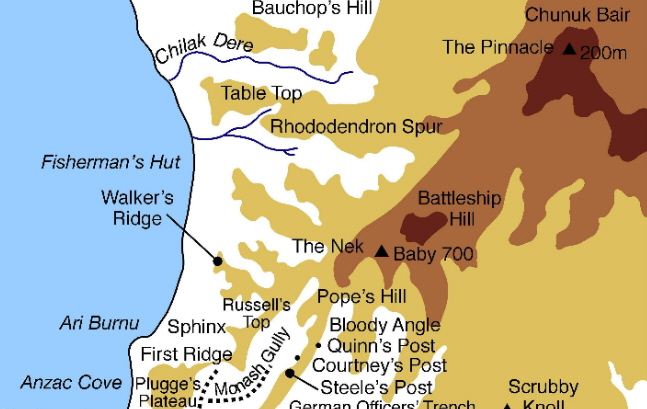
Anzac Sector, Partial Map Showing Locations Discussed in the Article
Battleship Hill was briefly occupied (but not held) by advance units of the Anzacs on 25 April but was successfully
defended by Kemal's newly-arrived units and held by the Turks for the rest of the campaign. It was a near thing for the Anzacs, though. That morning Lt. Eric Tulloch of the 11th and Captain Joseph Lalor of the 12th Australian Battalion, had landed with their men on North Beach, just north of Anzac Cove. Being fired at immediately from the high ground above they quickly started their ascent up to the series of ridges before them. Eventually, they reached a narrow saddle, later named the Nek, that connected to the slopes of Baby 700. With
Lalor and his men in reserve, Tulloch, his platoon, and a second platoon that had made a timely arrival carried on trying to gain control of Battleship Hill, where a rendezvous had been planned, pursuant to a further advance to Chunuk Bair.
They made steady progress, until they reached a position on the inland slope of Battleship Hill. There,
Tulloch was faced with a growing problem: at every hillcrest they had crossed so far, Turkish opposition had
increased, and now he was facing a deep dip in front of his small force with a line of Turks on the slope
behind it. Their fire was so intense that his men could only lie down in the shrub that covered the entire
area. It was now past 9 o'clock in the morning. Tulloch could see the first slope of Chunuk Bair, only one km.
distant, but any attempt to advance upon it seemed impossible. When new Turkish troops appeared on the scene and threatened to outflank him, his only option was to retreat to Baby 700, where in the meantime another fight had developed. Baby 700 was also lost eventually. Tulloch's advance to Battleship Hill was the high water mark for the Anzacs on 25 April.
Turkish troops were dug in on Battleship Hill, having seen firsthand its value in defending the strategic high
ground. The fighting in this sector soon took on the character of the Western Front with trenches, sniping, and deadly artillery fire. The aerial photo below shows the extensive trenches at Baby 700 and Battleship Hill.

Trenches at Battleship Hill and Baby 700: Left, Turkish Trench Today; Right, RNAS Aerial Photo, October 1915
Battleship Hill and Baby 700 would remain in Turkish hands until the withdrawal from the Anzac sector in December 1915. A plan to recapture them was part of the Suvla Bay operation in August. Chunuk Bair was to be gained first with an attack from another section, and then defenders on Battleship Hill and Baby 700 rolled up from the rear. The Allied occupation of Chunuk Bair was only minimal, however, as the Allied troops they were once again driven off by infantry commanded by that man of destiny, Mustafa Kemal. Battleship Hill remained a Turkish bastion for the rest of the land campaign.
Adapted From the Australian War Memorial and Gallipoli.com websites
|
|

A Forgotten Battle
The Army Brigade of the AEF's 2nd Division
at Vaux
Where: The Aisne-Marne Sector, 3.5 miles immediately northwest of the town of Château-Thierry on the River Marne, just off the lower right of the map below.
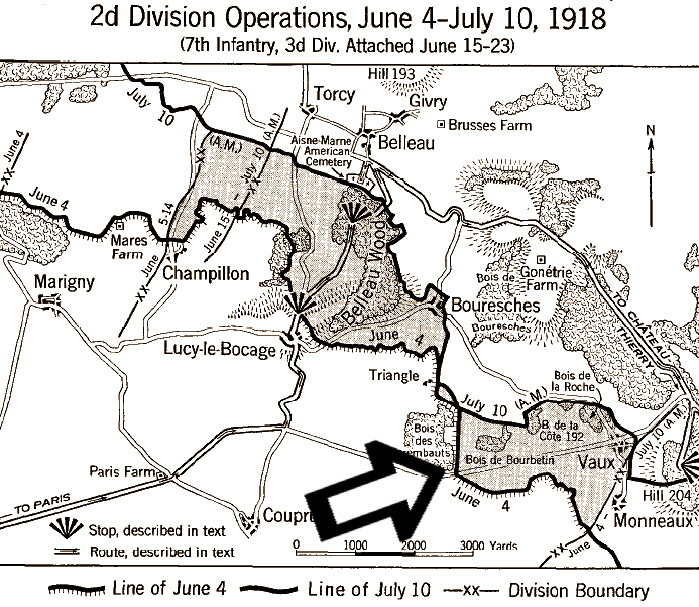
When: July 1 - 2, 1918
AEF Units Participating: Under command of the III Corps of the Sixth French Army - Second Division Key Commanders and Units: General Lewis, commanding the 3rd Brigade, Colonel Malone of the 23rd Infantry, Colonel Upton of the 9th Infantry, and Colonel Bowley of the 17th Field Artillery.
Opposing Forces: From German Army Group Crown Prince - 402nd Infantry Regiment and other supporting units.
Memorable As: A well-executed tactical operation to close out 2nd Division activity around Château-Thierry.
The Story:
During the fighting for the Bois de Belleau by the 2nd Division's 4th (Marine) Brigade, the front of the 3rd Brigade (regular army troops) to the south and east, with the exception of the movement by the 23rd Infantry on 6 June, had been comparatively quiet. However, the brigade had not been inactive. Trench construction was pushed vigorously, and aggressive patrols dominated the enemy's front. However, the Germans had an outstanding observation position on nearby Hill 204. Artillery and machine gun fire raked the lines nightly, and by day took their toll on individuals or groups. A notable incident was a German gas attack on the night of 23-24 June which caused over 400 gas casualties.
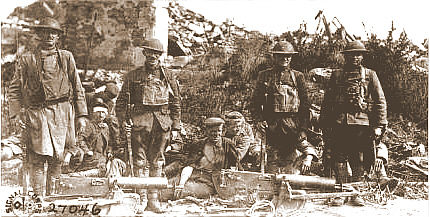
Members of the 9th Infantry with Prisoners at Vaux
The position of this brigade had never been satisfactory, forming as it did a deep indentation in the Allied line between the village of Bouresches and Château-Thierry. The idea emerged for a series of partial operations, each well supported by artillery, which would culminate in the capture of the village of Vaux. The two infantry regiments of the 3rd Brigade would attack side by side with the 23rd on the left assaulting the Bois de la Roche and the 9th Infantry taking the village itself and the southern edge of the wood. The culminating assault was made in conjunction with a French attack on hard-to-capture Hill 204 on the right [southeast]. The French 153rd division there would be supported by four companies of the U.S. 28th Division from the Pennsylvania National Guard.
The hour for attack was fixed at 6.00 P.M. on 1 July. All advanced positions were evacuated and the artillery preparations began at 5:00 A.M. Its maximum intensity was reached at 5:00 P.M., when the infantry took the attack formation. At 5:57 the rolling barrage fell; at 6:00 it began to move forward, a hundred yards every two minutes, slowing down slightly after passing Vaux. The infantry followed closely. The artillery had done its work with remarkable thoroughness and had driven the enemy to cover. Groups that attempted serious resistance were promptly flanked and taken. Within one hour after the barrage was placed beyond the objective, all Germans remaining within it were killed or captured, and the Americans were digging in on the line as planned.
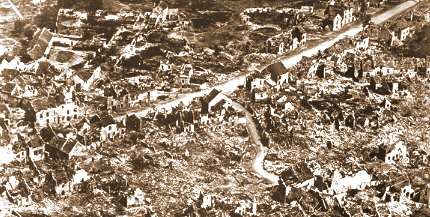
Village of Vaux, Leveled by the Barrage on 1 July
The single threat to the Americans' advance was on the right where the French 153rd division had trouble advancing up Hill 204 and left the 9th Infantry's flank exposed. The German forces would cling tenaciously to the crest of Hill 204 until it was forced to evacuate it on the night of 20-21 July. For the 3rd Brigade, overall, all objectives were gained within two hours. A German counterattack early in the morning of July 2 was repulsed with heavy losses. In all, over 400 prisoners and much materiel were captured. Further local attacks completed the straightening of the front in the sector by 10 July, when the division was pulled briefly from the line. The small, precisely planned and executed operation around Vaux was early display of tactical competence by the AEF.
|
|

Flyer for 2014 "Opening Moves" Trip Now Available
(download pdf file here)

Click on Image to Send Email
|

|

Another installment of our new feature, "What Did Houdini Do During the Great War?", that focuses on unknown or unlikely participants in the war. (We need a continuous flow of suggested names from the readers to continue this feature.)
J.H. Patterson (1867-1947)
Engineer, Hunter, Author, Soldier, Zionist
|
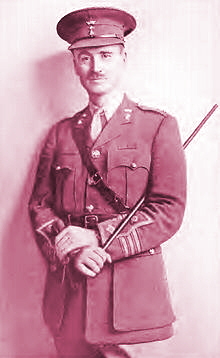
| |
After 1898, Lt. Col. John Patterson, having killed the two notorious "Man-Eating Lions of Tsavo" (up to 135 victims between them), was the world's most famous "big-game" hunter. This achievement, however, was simply one on his remarkable resume. He built bridges around the British Empire and would go on to become a colonial administrator and gamekeeper in Africa, and a best-selling author. But he never lost his military connection. He fought in the Boer War under Edmund Allenby, and when the Great War came, almost immediately, he found his way to Flanders, before sailing on to the Middle East in 1915 where he was given command of the Zion Mule Corps. Those Jewish soldiers and mules led by Patterson landed at Gallipoli on V Beach shortly after the assault began. They provided valuable support for the British and Anzac forces right up to the evacuation. On 17 July 1917, Patterson was made commander of the 38th Battalion of the Royal Fusiliers, one of three battalions of the "Jewish Legion," recruited from British and foreign Jews. In Palestine and Transjordan, Patterson's battalion saw the most action of the three and was later given the honor of parading in London. A religious man, Patterson, in the course of commanding Jewish troops, became a dedicated Zionist, supporting the cause after his Army retirement, up to his death in 1947.
|
Babe Ruth (1894-1948)
Baseball Player
The Great War led to manpower turmoil for Major League Baseball's 1918 season. A few key players had volunteered for service earlier and then the nation's Provost Marshal Enoch Crowder (the man in charge of the draft) issued a "work or fight" order in June. Previously, it was felt that baseball was helping the national morale during a time of crisis, so local draft boards unofficially exempted baseball stars. That changed after Crowder's order and rosters started to thin out through the rest of the season.
Babe Ruth of the Boston Red Sox, going into the 1918 season, was considered one of the game's best left-handed pitchers, having won 24 games in 1917. The 1918 personnel problems of his team, however, led the management to take advantage of his comparable skills as a batter. Playing only part-time in the outfield, Ruth ended the season batting .300 and led the league in home-runs for the first time. When the Red Sox won the pennant and made it to the World Series, though, they took full advantage of the Babe's pitching skills. He won two games, set a record for consecutive scoreless innings, and was considered the star of the series.
Looming over the baseball, though, was the war. America, as the series finished on 11 September, was about to launch its two greatest offensives of the struggle when casualties dramatically rose. Shirkers were increasingly scorned. Ruth was not a draft avoider; he had simply not been called by his draft board. But in the light of the "work or fight" order, even baseball's most prominent player needed to adhere. He found work briefly at a shipyard—possibly more symbolically that strenuously—before the Armistice came. Soon, some of baseball's other stars who had actually served in France, like Grover Cleveland Alexander and Ty Cobb, returned. They provided a contrast to the Babe, who had not fought.
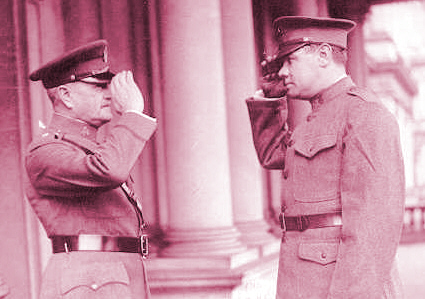
Ruth blossomed further as a phenomenal batter in 1919 yet found himself on the way to the New York Yankees, afterward, in the most famous trade in sports history. A vague, but difficult to kick reputation as a wartime slacker followed him to the big city. Eventually, in a grand public relations gesture, the Babe enlisted in the 104th Field Artillery of the New York National Guard in 1924. A famous photograph with General Pershing (above) got him off the "slacker" hook and he went on to become the most-beloved star in baseball history. During WWII, despite his declining health, he was an outspoken supporter of the nation's war effort.
Thomas Mann (1875-1955)
Author
By 1914 Thomas Mann was already recognized as one of Europe's greatest authors, having published Buddenbrooks (1901) and Death in Venice (1912). He continued writing notable novels and essays through his death in Switzerland in 1955. His political views that are remembered today mainly involve his denunciation of Nazism during World War II, when he was living in the United States.
Somewhat forgotten, though, are his writings from the First World War in which he defended the kaiser's regime and German culture against the western democracies:
I myself confess that I am deeply convinced that the German people will never be able to love political democracy simply because they cannot love politics itself, and that the much decried "authoritarian state" is and remains the one that is proper and becoming to the German people, and the one they basically want. A certain amount of courage is required today to express this conviction. Nevertheless, in doing so, I not only intend no derogation of the German nation in the intellectual or in the moral sense — I mean just the opposite — I also believe that its will to power and worldly greatness (which is less a will than a fate and a world necessity) remains completely uncontested in its legitimacy and its prospects.From "Reflections of a Nonpolitical Man" (1918)
Mann would later disavow these sentiments and become a major supporter of the Weimar Republic.
|
|

Lille Munitions Explosion of 11 January 1916
At 3:30 A.M. on 11 January 1916 German-occupied Lille, France, was rocked by an enormous explosion which lit up the night's sky: the munitions depot known as "18 Ponts" had just exploded. Situated on the edge of Boulevard de Belfort, the depot comprised a series of 18 vaulted bunkers (the 18 ponts) which once served as powder magazines. The bunkers were arranged in a circle and comprised two levels with deep tunnels protected by a thick layer of earth which the Germans found ideal for storing munitions and other explosives.
The explosion totally destroyed the munitions depot and left behind it a huge crater 150 meters in diameter and about 30 meters deep. Casualties were considerable with 104 dead, including whole families, and 300 to 400 wounded of which 116 were in a serious condition. The official German death toll numbered 30. The cause of the catastrophe was never clearly ascertained. Some talked of an attack, perhaps a bomb dropped from a British aeroplane although no one heard any engine noise to corroborate this. The most likely cause was the spontaneous detonation of some poor quality and unstable explosives which were stored in the depot.
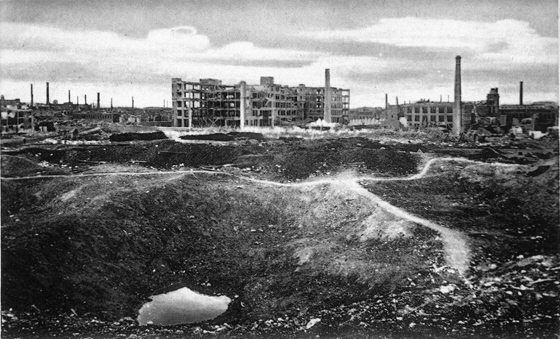
Details from the Remembrance Trails of Northern France website, photo from German History Documents Website
|
|
|

|
The Beauty and the Sorrow,
An Intimate History of the First World War
By Peter Englund
Reviewed by Jane Mattisson
|
|
The Beauty and the Sorrow by the eminent Swedish historian Peter Englund is a European bestseller. Already available in 18 different languages, it is currently being translated into Estonian and is shortly to be translated into Chinese. Drawing on the diaries and letters of 20 individuals from both sides and from all around the world, The Beauty and the Sorrow is not a conventional history of the war. Instead, through personal letters, diaries, and other materials the book offers a unique insight into how the First World War was experienced, incorporating its tragedy, horror, absurdity, monotony, and even beauty. The selected individuals are not exceptional; they represent the experience of the average individual: male and female, soldier and non-combatant.
Peter Englund, professor, historian, and writer, was appointed permanent secretary of the Swedish Academy in 2008. He was awarded the August Prize in 1993 and the Selma Lagerlöf Literature Prize in 2002. His first collection of essays, Förflutenhetens landskap (1991, The Landscape of the Past) incorporates both "large history" in the form of war, revolution, and battlefields and "small history," focusing on the personal specifics of such entities as time, dirt, and terror. The combination of the two is a recurring theme in Englund's work. He has also been a reporter for the Swedish newspapers Expressen and Dagens Nyheter, operating in such areas as Croatia, Bosnia, Afghanistan, and Iraq. A specialist in 17th-century history, he has published widely on the twentieth century, including Brev från nollpunkten (1996; Letters from Ground Zero). He has taught the First World War at university level for many years.
Both the content and style of The Beauty and the Sorrow make it read like a novel. The twenty individuals listed at the beginning of the book as "Dramatis Personae" are presented as "characters" with specific wartime occupations. Their ages are also included, and through their eyes we experience a vast panorama of the horrors, hardships and even small pleasures that the war brought to countless individuals in every theater of conflict. Englund was surprised to discover that the diaries of women were particularly useful in identifying feelings. This isn't a question of gender, he maintains, but of circumstance: men were often to be found at the center of dramatic events; time for reflection or emotion was limited.
The Beauty and the Sorrow describes each year of the war in separate sections containing material by the 20 individuals selected. Each section opens with a chronology of the year to give context. The entries are accompanied by copious footnotes explaining references and place names, and provide useful background information. The entries are chosen on the basis of their relevance to the selected days and months of the year. Variety is ensured by the avoidance of two consecutive entries by the same individual. The number of entries is particularly large for the years 1915-1917. This, according to Englund, is due to the fact that the war did not begin until August 1914, and the most important battles and events took place between 1915 and 1917. In the edition to be published in 2014 (of which more shortly), additional material will be added to the section on 1918, most notably on the American involvement in the war.
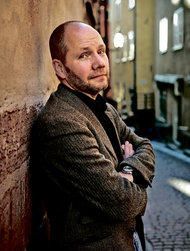
Author Peter Englund |
It's particularly interesting that the content of The Beauty and the Sorrow is amended for each language and country: new individuals are introduced and others excluded to suit the country for which the edition has been translated. Englund has studied more than 1,000 individuals in total; this number is increasing as new editions are produced. Plans are under way to produce a collected edition incorporating all the translations and their various additional characters, and this comprehensive volume is to be published in 2014. All versions of the book include an excellent bibliography and a large selection of high-quality illustrations, including portraits or specific areas of fighting: the Western Front, East Africa, the Eastern Front, the Italian Front, the Balkans and the Dardanelles, and the Middle East. The index, comprising 15 pages, is detailed and informative.
In a telephone conversation I recently had with the author, he reflected on his position as a Swede recording the history of a war in which his own country played no active part. The Beauty and the Sorrow is dedicated to Carl Englund, a distant relative of the author. While Peter Englund is currently investigating the war career of this distant relative, he stresses that the latter has had no significant impact on the contents of The Beauty and the Sorrow. With regard to Englund's Swedish nationality, he sees this is an advantage because it gives him a political and personal distance to the subject. World War Two is much better known in Sweden and is taught in secondary and high schools as well as at university. Englund hopes that The Beauty and the Sorrow will stimulate Swedish interest in World War One. His book is already an important addition to the human history of the Great War for readers of at least a score of languages.
The Beauty and the Sorrow, An Intimate History of the First World War; Peter Englund; London, Profile Books, 2011
532 pp., ISBN: 978-1846683428.
|
|
|
|








 Click on Title or Icon to Access
Click on Title or Icon to Access
